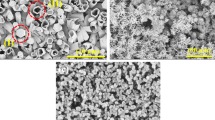Abstract
Template-assisted nanofabrication is a simple and effective method to produce various nanostructure morphologies by controlling the polymer, solvent, and template characteristics. In this study, the importance of the surface interactions between the solution and the template in controlling the morphology of the nanostructures has been highlighted. Contact angles between various polymer solutions and anodized aluminum oxide (AAO) templates have been determined. The morphology of the resultant nanostructures has been correlated with the measured contact angles between solution and template. It is generally observed that nanorods (diameter of 100–350 nm) are produced at low contact angles, whereas nanotubes (diameter of 200–400 nm) tend to form at high contact angles. Therefore, desired nanostructure morphology for a given application can be obtained by controlling the initial wetting interaction between solution and template.




Similar content being viewed by others
References
Bechara S, Wadman L, Popat KC (2011) Electroconductive polymeric nanowire templates facilitates in vitro C17. 2 neural stem cell line adhesion, proliferation and differentiation. Acta Biomater 7(7):2892–2901
Buijnsters JG, Zhong R, Tsyntsaru N, Celis JP (2013) Surface wettability of macroporous anodized aluminum oxide. Appl Mater CRC Interfaces 5(8):3224–3233
Chen JT, Wei TH, Chang CW, Ko HW, Chu CW, Chi MH, Tsai CC (2014) Fabrication of polymer nanopeapods in the nanopores of anodic aluminum oxide templates using a double-solution wetting method. Macromolecules 47(15):5227–5235
Dimitrov DI, Milchev A, Binder K (2007) Capillary rise in nanopores: molecular dynamics evidence for the Lucas-Washburn equation. Phys Rev Lett 99(5):054501
Dougherty S, Liang J (2009a) Fabrication of segmented nanofibers by template wetting of multilayered alternating polymer thin films. J Nanopart Res 11(3):743–747
Dougherty S, Liang J (2009b) Core–shell polymer nanorods by a two-step template wetting process. Nanotechnology 20(29):295301
Dougherty SA, Liang J, Kowalik TF (2009a) Template-assisted fabrication of protein nanocapsules. J Nanopart Res 11(2):385–394
Dougherty SA, Zhang D, Liang J (2009b) Fabrication of protein nanotubes using template-assisted electrostatic layer-by-layer methods. Langmuir 25(22):13232–13237
Feng X, Jin Z (2009) Spontaneous formation of nanoscale polymer spheres, capsules, or rods by evaporation of polymer solutions in cylindrical alumina nanopores. Macromolecules 42(3):569–572
Li T, Zeng W, Zhao W (2016) Gas sensing performance of multiple SnO2 1D nanostructures based on their interconnect manner. Mater Lett 167:230–233
Mark JE (1999) Polymer data handbook. Oxford University Press, New York
Mijangos C, Hernandez R, Martin J (2016) A review on the progress of polymer nanostructures with modulated morphologies and properties, using nanoporous AAO templates. Prog Polym Sci 54:148–182
Mozaffari S, Tchoukov P, Atias J, Czarnecki J, Nazemifard N (2015) Effect of asphaltene aggregation on rheological properties of diluted athabasca bitumen. Energy Fuel 29(9):5595–5599
Mozaffari S, Tchoukov P, Mozaffari A, Atias J, Czarnecki J, Nazemifard N (2017a) Capillary driven flow in nanochannels—application to heavy oil rheology studies. Colloids Surf A Physicochem Eng Asp 513:178–187
Mozaffari S, Li W, Thompson C, Ivanov S, Seifert S, Lee B et al (2017b) Colloidal nanoparticle size control: experimental and kinetic modeling investigation of the ligand–metal binding role in controlling the nucleation and growth kinetics. Nano 9(36):13772–13785
Pasquali M, Liang J, Shivkumar S (2010) Role of template and infiltration technique on resulting morphology of polymer nanostructures. Mater Lett 64(18):1943–1946
Pasquali M, Liang J, Shivkumar S (2011) Role of AAO template filling process parameters in controlling the structure of one-dimensional polymer nanoparticles. Nanotechnology 22(37):375605
Redón R, Vazquez-Olmos A, Mata-Zamora ME, Ordonez-Medrano A, Rivera-Torres F, Saniger JM (2006) Contact angle studies on anodic porous alumina. Rev Adv Mater Sci 11(1):79–87
Schlitt S, Greiner A, Wendorff JH (2008) Cylindrical polymer nanostructures by solution template wetting. Macromolecules 41(9):3228–3234
Shin K, Obukhov S, Chen JT, Huh J, Hwang Y, Mok S et al (2007) Enhanced mobility of confined polymers. Nat Mater 6(12):961–965
Song G, She X, Fu Z, Li J (2004) Preparation of good mechanical property polystyrene nanotubes with array structure in anodic aluminum oxide template using simple physical techniques. J Mater Res 19(11):3324–3328
Steinhart M, Wendorff JH, Wehrspohn RB (2003) Nanotubes à la carte: wetting of porous templates. ChemPhysChem 4(11):1171–1176
Xia Y, Yang P, Sun Y, Wu Y, Mayers B, Gates B et al (2003) One-dimensional nanostructures: synthesis, characterization, and applications. Adv Mater 15(5):353–389
Author information
Authors and Affiliations
Corresponding author
Ethics declarations
Conflict of interest
The authors declare that they have no conflict of interest.
Rights and permissions
About this article
Cite this article
Costa, N., Li, P., Xu, Y. et al. Effect of contact angle on the morphology of nanostructures produced by solution wetting of anodized aluminum oxide templates. J Nanopart Res 20, 103 (2018). https://doi.org/10.1007/s11051-018-4204-8
Received:
Accepted:
Published:
DOI: https://doi.org/10.1007/s11051-018-4204-8




